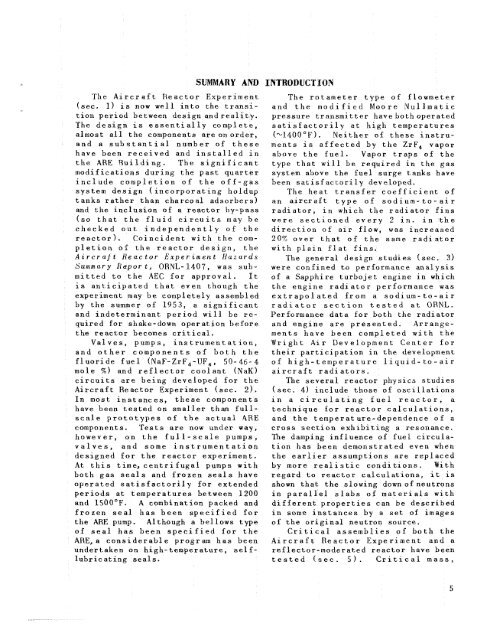the Molten Salt Energy Technologies Web Site
the Molten Salt Energy Technologies Web Site
the Molten Salt Energy Technologies Web Site
You also want an ePaper? Increase the reach of your titles
YUMPU automatically turns print PDFs into web optimized ePapers that Google loves.
SUMMARY AND<br />
The Aircraft Heactor Experiment<br />
isec. 1) is now well into <strong>the</strong> transition<br />
period between design and reality.<br />
The design is essentially complete,<br />
almost all <strong>the</strong> components areonorder,<br />
end a substantial number of <strong>the</strong>se<br />
have been received and installed in<br />
<strong>the</strong> ARE rjuilding. The significant<br />
modifications during <strong>the</strong> past, quarter<br />
include cornplet,ion af <strong>the</strong> off-gas<br />
system design (incorporating holdup<br />
tanks ra<strong>the</strong>r than charcoal adsorbers)<br />
and <strong>the</strong> inclusion of a reactor hy-pass<br />
(so that <strong>the</strong> fluid circuits may be<br />
checked out independently of <strong>the</strong><br />
reactor). Coincident with <strong>the</strong> completion<br />
of <strong>the</strong> reactor design, <strong>the</strong><br />
Aircraft Reactor Experiment Hazards<br />
Summary Itspor t, ORNL-1407, was submitted<br />
to <strong>the</strong> AEC for approval. It<br />
is anticipated that even though <strong>the</strong><br />
experiment may be completely assembled<br />
by <strong>the</strong> summer of 1953, a significant<br />
and indeterminant period will be required<br />
for shake-down operation before<br />
<strong>the</strong> reactor becomes critical.<br />
Val v e s , p ump s ,<br />
i ns t rumen t a t i o n I<br />
and o<strong>the</strong>r components of both <strong>the</strong><br />
fluoride fuel (NaF-ZrF4-UF, , 50- 46- 4<br />
mole 7%) and reflector coolant (NaK)<br />
circuits are being developed for <strong>the</strong><br />
Aircraft Reactor Experiment (sec. 2).<br />
In most, instances, <strong>the</strong>se components<br />
have been tested on smaller than full-<br />
scale prototypes of <strong>the</strong> actual ARE<br />
components. Tests are now under way,<br />
however, on <strong>the</strong> full-scale pumps,<br />
valves, and some instrumentation<br />
designed for <strong>the</strong> reactor experiment.<br />
At this time, centrifugal pumps with<br />
both gas seals and frozen seals have<br />
operated satisfactorily for extended<br />
periods at temperatures between 1280<br />
and 1500°F. A combination packed and<br />
frozen seal has been specified far<br />
<strong>the</strong> ARE pump. Although a bellows type<br />
of seal has been specified for <strong>the</strong><br />
ARE, a considerable program has been<br />
undertaken on high-temperature, self-<br />
lubr ic at in8 seal s.<br />
INTRODUCTION<br />
The rotameter type of flowmeter<br />
and <strong>the</strong> modified Moore Nullmatic<br />
pressure transmitter havebothoperated<br />
satisfactorily at high temperatures<br />
(-140OOF). Nei<strong>the</strong>r of <strong>the</strong>se instru-<br />
ments is affected by <strong>the</strong> ZrF, vapor<br />
above <strong>the</strong> fuel. Vapor traps of <strong>the</strong><br />
type that will be required in <strong>the</strong> gas<br />
system above <strong>the</strong> fuel surge tanks have<br />
been satisfact,orily developed.<br />
The heat transfer coefficient of<br />
an aircraft type of sodium- to- air<br />
radiator, in which <strong>the</strong> radiator fins<br />
were sectioned every 2 in. i n <strong>the</strong><br />
direction of air flow, was increased<br />
20% over that of <strong>the</strong> same radiator<br />
with plain flat fins.<br />
The general design studies Isec. 3)<br />
were confined to performance analysis<br />
of a Sapphire turbojet: engine in which<br />
<strong>the</strong> engine radiator performance was<br />
extrapolated from a sodium-to-air<br />
radiator section tested at ORNL.<br />
Performance data for both <strong>the</strong> radiator<br />
and engine are presented. Arrange-<br />
ments have been completed with <strong>the</strong><br />
Wright Air Development Center for<br />
<strong>the</strong>ir participation in <strong>the</strong> development<br />
of high-temperature liquid-to-air<br />
aircraft radiators.<br />
The several reactor physics studies<br />
(sec. 4) include those of oscillations<br />
in a circulating fuel reactor, a<br />
technique for reactor calculations,<br />
and <strong>the</strong> temperat ure-dependence of a<br />
cross section exhibiting a resonance.<br />
The damping influence of fuel circula-<br />
tion has been demonstrated even when<br />
<strong>the</strong> earlier assumptions are replaced<br />
by more realistic conditions. With<br />
regard to reactor calculations, it is<br />
shown that <strong>the</strong> slowing down of neutrons<br />
in parallel slabs of materials with<br />
different properties can be described<br />
in some instances by a set of images<br />
of <strong>the</strong> original neutron source.<br />
Critical assemblies of both <strong>the</strong><br />
Aircraft Reactor Experiment and a<br />
ref 1 ec to r -mode rated re actor have been<br />
tested (sec. 5 ) . Critical mass,



![Review of Molten Salt Reactor Physics Calculations [Disc 2]](https://img.yumpu.com/21979492/1/190x247/review-of-molten-salt-reactor-physics-calculations-disc-2.jpg?quality=85)












